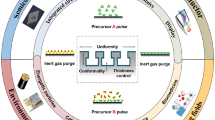Abstract
THE formation of nanometre-scale surface structures by atomic manipulation with the scanning tunnelling microscope has opened up opportunities for creating new metastable states of matter atom by atom1. The technique allows the fabrication of arbitrary structures, but its application may be limited by considerations of speed, as only one nanostructure can be built at a time. Here we describe the simultaneous formation of many densely packed nanostructures of various morphologies using diffusion-controlled aggregation on surfaces. By exploiting the dependence of the mobility of adsorbed atoms on substrate crystal face and temperature, we are able to grow linear, two-dimensional or tenuous fractal aggregates of nanometre dimensions. The high number density (1011& minus;1014 cm& minus;2) of these structures means that their physical and chemical properties can be easily measured with conventional surface spectroscopies.
Similar content being viewed by others
References
Eigler, D. M. & Schweizer, E. K. Nature 344, 524–526 (1990).
Kern, R. in Interfacial Aspects of Phase Transitions (ed. Mutaftschiev, B.) 287–312 (Reidel, Dordrecht, 1982).
Witten, T. A. & Sander, L. M. Phys. Rev. B27, 5686–5697 (1983).
Hwang, R. Q., Schröder, J., Günther, C. & Behm, R. J. Phys. Rev. Lett. 67, 3279–3282 (1991).
Roeder, H., Brune, H., Bucher, J. P. & Kern, K. Surf. Sci. (in the press).
Venables, J. A., Spiller, G. D. T. & Hanbücken, M. Rep. Prog. Phys. 47, 399–459 (1984).
Ayrault, G. & Ehrlich, G. J. Chem. Phys. 60, 281–294 (1974).
Michely, Th. & Comsa, G. Surf. Sci. 256, 217–226 (1991).
Jena, P., Khanna, S. N., Rao, B. K. (eds) Physics and Chemistry of Finite Systems: From Clusters to Crystals (Kluwer, Dordrecht, 1992).
Massobrio, C. & Blandin, Ph. Phys. Rev. B47, 13687–13694 (1993).
Solyom, J. Adv. Phys. 28, 201–303 (1979).
Bonzel, H. in Diffusion in Metals and Alloys (ed. Mehrer, H.) Ch. 13 (Springer, Berlin, 1992).
Bucher, J. P., Hahn, E., Fernandez, P., Massobrio, C. & Kern, K. Phys. Rev. Lett. (submitted).
Tsong, T. T., Liu, J. & Wu, C. W. in Physics and Chemistry of Finite Systems: From Clusters, to Crystals (eds Jena, P et al.) 1039–1045 (Kluwer, Dordrecht, 1992).
Basset, D. W. Thin Solid Films 48, 237–249 (1978).
Fink, H. W. & Ehrlich, G. Surf. Sci. 110, L611–L614 (1981).
Schwoebel, P. R. & Kellog, G. L. Phys. Rev. Lett. 61, 578–581 (1988).
Wright, A. F., Daw, M. S. & Fong, C. Y. Phys. Rev. B42, 9409–9419 (1990).
Fernandez, P. & Massobrio, C. Surf. Sci. (submitted).
Author information
Authors and Affiliations
Rights and permissions
About this article
Cite this article
Röder, H., Hahn, E., Brune, H. et al. Building one- and two-dimensional nanostructures by diffusion-controlled aggregation at surfaces. Nature 366, 141–143 (1993). https://doi.org/10.1038/366141a0
Received:
Accepted:
Issue Date:
DOI: https://doi.org/10.1038/366141a0
- Springer Nature Limited
This article is cited by
-
Bismuth sulfide photocatalysis water treatment under visible irradiation
Research on Chemical Intermediates (2021)
-
A fractional diffusion equation with sink term
Indian Journal of Physics (2020)
-
Fabrication of MoSe2 nanoribbons via an unusual morphological phase transition
Nature Communications (2017)
-
Clustering on Magnesium Surfaces – Formation and Diffusion Energies
Scientific Reports (2017)
-
Nanoscale arrays of antimony telluride single crystals by selective chemical vapor deposition
Scientific Reports (2016)





